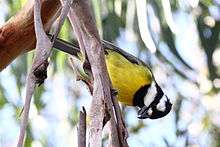Crested shriketit
| Crested shriketit | |
|---|---|
 | |
| Male | |
| | |
| Female | |
| Scientific classification | |
| Kingdom: | Animalia |
| Phylum: | Chordata |
| Class: | Aves |
| Order: | Passeriformes |
| Suborder: | Passeri |
| Family: | Pachycephalidae |
| Genus: | Falcunculus |
| Species: | F. frontatus |
| Binomial name | |
| Falcunculus frontatus (Latham, 1801) | |
| Subspecies | |
|
see text | |
| Synonyms | |
| |
The crested shriketit (Falcunculus frontatus), or Australian shriketit, is a bird endemic to Australia where it inhabits open eucalypt forest and woodland. It is the only species contained within both the subfamily Falcunculinae and the genus Falcunculus.
Taxonomy and distribution
The crested shriketit was first described by the English ornithologist John Latham in 1801 under the binomial name Lanius frontatus.[2] Nuclear gene sequencing suggests that the crested shriketit and the wattled ploughbill may require their own family, Falcunculidae (Dickinson 2003).
Subspecies
Three subspecies are recognized, with disjunct ranges and sometimes considered full species:[3][4]
- Northern shriketit (F. f. whitei), or White's shrike-tit - Campbell, AJ, 1910: Originally described as a separate species. Rare, with isolated records in the Kimberley region of north-western Australia and the Top End of the Northern Territory
- Western shriketit (F. f. leucogaster), or White-bellied shrike-tit - Gould, 1838: sparsely distributed in south-western Western Australia
- Eastern shriketit (F. f. frontatus) - (Latham, 1801): the stronghold of the species in south-eastern Australia from the Lower South-East of South Australia, coastally and in the Murray-Darling Basin to south-eastern Queensland, with some scattered occurrences further north and west in Queensland
Description
Males are larger than females in wing length, weight, and bill-size.[5] Males have black throats, while females have olive green.
Behaviour
.jpg)
It feeds mainly on insects, spiders and, sometimes, particularly during the breeding season, young birds. Thistles are also taken. It has a parrot-like bill, used for distinctive bark-stripping behaviour, which gains it access to invertebrates.
Status and conservation
The eastern shriketit is evaluated as being of least concern on the IUCN Red List of Threatened Species, the northern shriketit is considered endangered, and the western shriketit is listed as near threatened.[1] Both the northern and western crested shriketits suffer from habitat loss and fragmentation.[6]
References
Notes
- 1 2 BirdLife International (2016). "Falcunculus frontatus". IUCN Red List of Threatened Species. Version 2016.3. International Union for Conservation of Nature. Retrieved 27 January 2017.
- ↑ Latham, John (1801). Supplementum indicis ornithologici sive systematis ornithologiae (in Latin). London: Leigh & Sotheby. p. xviii.
- ↑ "IOC World Bird List 7.1". IOC World Bird List Datasets. doi:10.14344/ioc.ml.7.1.
- ↑ Higgins, P. J.; Peter, J. M. (2002). Handbook of Australian, New Zealand and Antarctic Birds. Vol.6 Pardalotes to Shrike-thrushes (1. publ. ed.). Melbourne: Oxford University Press. pp. 1050–1063. ISBN 0-19-553762-9.
- ↑ Noske, Richard (2003). "Does the crested shrike‐tit Falcunculus frontatus exhibit extended parental care?". Corella. 27: 118–119.
- ↑ West, Judy. "Water for a Healthy Country" (PDF). Commonwealth Scientific and Industrial Research Organisation. Retrieved 12 November 2011.
Sources
- Josep del Hoyo; Andrew Elliott; David Christie (2007). Handbook of the Birds of the World Picathartes to tits and chickadees. Lynx Communications. ISBN 978-84-96553-42-2.
- Dickinson, E. C. 2003. The Howard & Moore Complete Checklist of the Birds of the World. 3rd Ed. Princeton University Press, Princeton, N.J.
- Schodde, R. and I. J. Mason. 1999. Directory of Australian Birds. Passerines: i-x, 1-851. CSIRO Publishing, Canberra.
External links
| Wikimedia Commons has media related to Falcunculus frontatus. |
start class
